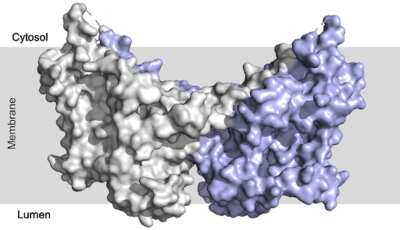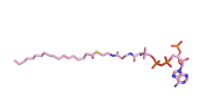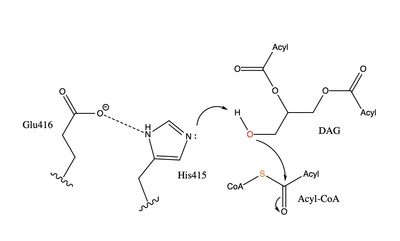Introduction
There are two families of DGAT proteins each with their own distinct cellular functions via synthesis of triacylglycerides from oleoyl-CoA. Diacylglycerol acyltransferase 1 (DGAT1) catalyzes the final and only committed step of triacylclygerol synthesis (Fig. 3). [1] It does this by using diacylglycerol (DAG) and oleoyl CoA as substrates. DGAT1 is located in the membrane of the endoplasmic reticulum and is important for metabolism through its uptake of diacylglycerides and synthesis of triacylglicerides. [2] This metabolism is involved in intestinal fat absorption, lipoprotein assembly, lactation, and adipose tissue formation [3].
Structural highlights
Conformation
There are three domains within the DGAT enzyme: cytosolic, transmembrane, and luminal. Most of the enzyme exists within the membrane with small portions peeking out into the cytosol of the cell or lumen of the endoplasmic reticulum. DGAT exists as a homodimer of two identical chains, A and B. The homodimer interface is stabilized in two different ways. First, the transmembrane region is stabilized through large between the TM1 helices on each of the chains. The second is through extensive between the two chains in the cytosolic domain. [2] [4]
Tunnel System
There are two main tunnels that allow the enzymatic activity of DGAT to occur. The first is a where the hydrophilic region of the oleyol-CoA binds to the cytosolic face that forms between helices TM6 and TM7. The
CoA region sits at the cytosolic face with the fatty acid chain extending the rest of the way through the enzyme tunnel.
[4] Researchers are currently unsure which residues are involved in the binding of the oleoyl-coA to the reaction chamber, but they believe that the hydrogen bonding of the coenzyme A motif that sits at the cytosolic face of the tunnel. When hydrophobic residues were substituted with the standard residues in the cytosolic tunnel, DGAT was completely inactivated.
[4] [2]
The second is a that is orthogonal to the cytosolic tunnel. This tunnel is in the transmembrane region of the enzyme which allows lipids in the membrane to easily access the location. [2] Researchers have hypothesized that this tunnel is able to differentiate between DAG, its intended substrate, from other groups that would typically interact with an acyl-CoA, like cholesterol, due to its bent architecture. The bent nature of the tunnel would inhibit more stiff and planar molecules from entering the tunnel and interfering with the activity of the enzyme. [2]
Active Site
The active site of DGAT is in the transmembrane region of the enzyme. When it is in its state and no oleoyl-CoA is in its tunnel, Met434 hydrogen bonds to the catalytic histidine, His415, which stabilizes the conformation. There are no major conformational changes that take place upon oleoyl-CoA binding into the cytosolic tunnel, however, several key residues change conformation to allow for correct positioning
of the ligand. In its conformation, His415 hydrogen bonds to Gln465 which stabilizes the histidine and allows it to be positioned near the thioester bond of the oleoyl-CoA.[2] His415 is now positioned to be able to interact with the DAG that enters through the lateral tunnel perpendicular to the cytosolic tunnel oleoyl-CoA enters through. has been hypothesized to be important in holding the DAG in a proper orientation to be able to interact with the oleoyl-CoA and undergo synthesis into a triglyceride. [2]
Mechanism
When a molecule of diacylglycerol (DAG), or another acyl acceptor, binds into this hydrophobic tunnel, the transfers the acyl group on the bound oleoyl-CoA to the DAG to form a triglyceride. The deprotonates the hydroxyl group on the C3 of the glycerol backbone. The Deprotonated oxygen then makes a nucleophilic attack on the carbonyl carbon of the Acyl-CoA, the electron density gets shifted up to the oxygen and the tetrahedral acyl-CoA-DAG intermediate is formed which is likely stabilized by Gln465.
[4]The electron density then falls back down to the carbonyl carbon and to the sulfur of the Acyl-CoA which accepts the added electron density and the bond between the sulfur and carbonyl carbon is broken. Glu416 likely provides enhancement of the reaction by deprotonating His415 which shifts the electron density and helps facilitate the deprotonation by His415 of the glycerol backbone despite being outside of the 3 angstrom hydrogen bonding distance. This is likely due to the fact that the DGAT 1 enzyme was unable to be visualized with the diacylglycerol in the active site. The entrance and binding of the diacylglycerol may cause conformational changes and shifting of the Glu416 to become closer to the His415. Point mutations made to His415 and Glu416 support the hypothesis that it is essential for catalysis in the active site since the enzyme function was completely eliminated when the mutation was made.
[4]
Inhibitors
Diseases
Studies show that reduced DGAT1 function in mice resulted in resistance to obesity when fed a high fat diet and reduced triacylglycerides. This leads to DGAT1 being a potential target for fatty liver disease and hypertriglyceridemia. Cite error: Invalid <ref> tag;
refs with no name must have content
A biallelic loss-of-function mutation in human DGAT1 results in severe congenital diarrhea and protein-losing enteropathy. This is a homozygous recessive mutation. This does not produce a complete-loss-of-function of DGAT1, but rather a partial reduction of triacylglyceride synthesis. [5]




